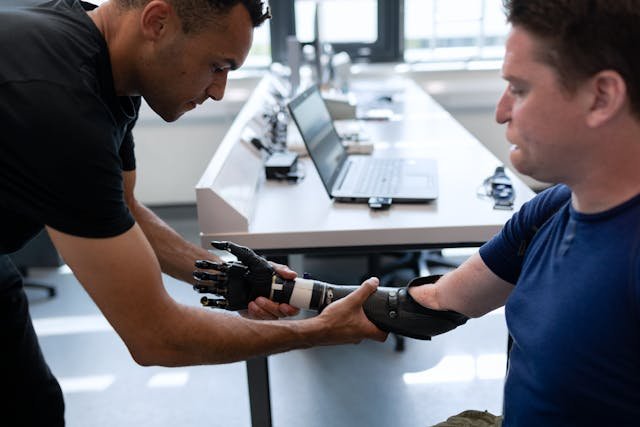For children born with upper limb differences, prosthetic arms can be an important part of learning, growing, and feeling independent. But with so many options available today, families often wonder what kind of prosthetic is best. Among the most advanced are myoelectric arms—devices that use muscle signals to control movement. They sound impressive, and in many ways, they are. But the big question remains: are myoelectric arms the right fit for children with congenital limb deficiencies?
At Robobionics, we’ve guided many families through this decision. We’ve seen how technology can change lives, but also how important it is to match the right prosthetic to the right child. This article explores the role of myoelectric arms in the lives of congenital amputees. We’ll help you understand what they are, how they work, and when they might be the right choice.
Understanding Congenital Limb Deficiencies
Children with congenital limb deficiencies are born without part or all of their upper limbs. These differences can affect the hand, forearm, or entire arm. Unlike those who lose a limb due to trauma or illness, children with congenital differences have never known any other way of living. Their brains and bodies have adapted from birth, and they often find creative ways to do things with what they have.
Natural Adaptation from the Start
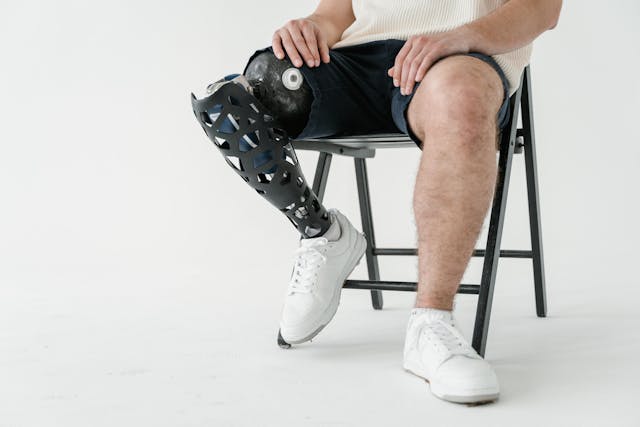
Because these children grow up using their residual limb naturally, they often develop their own techniques for daily tasks. They may use one hand for most things or use their feet and mouth for extra support. Many learn how to balance, play, and write in ways that feel natural to them, without even thinking twice about their limb difference.
While this independence is wonderful, it sometimes leads people to believe prosthetics aren’t needed. But the truth is, even with natural adaptation, a well-fitted prosthetic can add new possibilities. It’s not about replacing what’s missing—it’s about adding tools to make life easier.
At Robobionics, we always begin by observing how the child interacts with their world. This helps us decide if a prosthetic will support their freedom or get in the way of it.
Different Needs from Trauma Cases
When someone loses a limb later in life, they must relearn how to do things. They often want a prosthetic that restores what they lost. But children born with limb differences may not feel this loss in the same way. Instead, they see prosthetics as new tools—not replacements. This changes how they respond to devices, especially advanced ones like myoelectric arms.
Prosthetic success in congenital cases depends on timing, training, and whether the device truly fits the child’s needs and lifestyle. Myoelectric arms can be powerful, but they must be introduced with care and patience.
At Robobionics, we take the time to prepare families before jumping into high-tech solutions. Our goal is not just to provide a device, but to ensure it supports the child’s long-term comfort and confidence.
Emotional and Social Considerations
As children grow, their emotional needs change. In early childhood, many are focused on play and exploration. But by school age, they become more aware of their differences. They may notice curious looks or feel left out during group tasks. For some, this is when a prosthetic becomes more than just a tool—it becomes a source of confidence.
Myoelectric arms can help in this way. They often look more natural, with fingers that move and grip. They offer a sense of ability that goes beyond appearance. But they also come with responsibility and learning curves.
At Robobionics, we help children and families decide not only if a myoelectric arm will help physically, but also if it will support the child emotionally. We want every child to feel empowered—not overwhelmed.
What Is a Myoelectric Arm and How Does It Work?
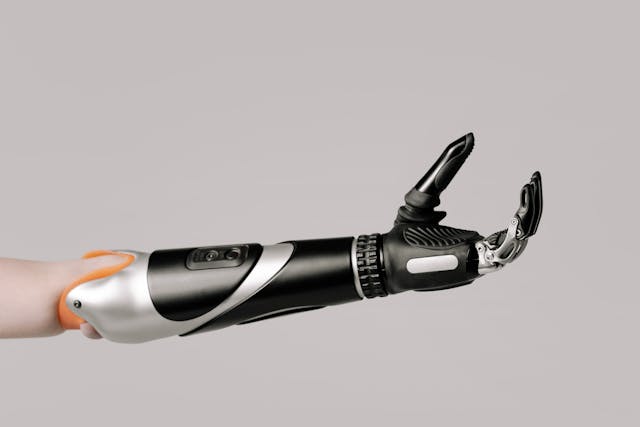
Myoelectric prosthetics are smart devices that use electrical signals from the body’s muscles to move a hand or arm. For someone with a congenital limb difference, the remaining muscles in their upper arm or shoulder can be trained to control the prosthetic.
Detecting Muscle Signals
Every time we move, our muscles send tiny electrical signals. Myoelectric prosthetics use sensors inside the socket to pick up these signals. When the user flexes specific muscles, the sensors detect the signal and translate it into motion—like opening or closing the hand, rotating the wrist, or changing grip patterns.
For congenital users, this means learning which muscles to activate and how to control them with precision. It can take time and practice, but many children are quick learners. With support from therapists and consistent training, myoelectric control becomes more natural.
At Robobionics, we provide gamified training tools that turn practice into play. This helps children enjoy the learning process and build muscle control at their own pace.
Components and Features
A typical myoelectric arm includes a custom socket, sensors, a battery, and a motorized hand. Some devices offer different grip modes, allowing the user to hold objects gently or firmly. Others include wrist rotation, which helps with daily tasks like brushing teeth or using a spoon.
These features allow for more precise and natural movement than body-powered or passive devices. However, they also require charging, regular maintenance, and careful use to avoid damage.
Robobionics offers modular designs so the prosthetic can grow with the child. We provide both basic and advanced options depending on the user’s comfort, readiness, and activity level.
Real-World Use and Practicality
While myoelectric arms can offer great function, they are not always needed in every moment. Some children may choose to wear them during school or social events but prefer not to use them at home. Others may rely on them for specific tasks and switch to a simpler device for outdoor play.
This flexibility is important. The prosthetic should fit the child’s life—not the other way around. Encouraging children to use their myoelectric device in ways that feel meaningful helps with long-term success.
At Robobionics, we don’t push constant wear. Instead, we support personalized use, allowing each child to decide how the device fits into their daily routines.
Weighing the Pros and Cons of Myoelectric Arms for Congenital Users
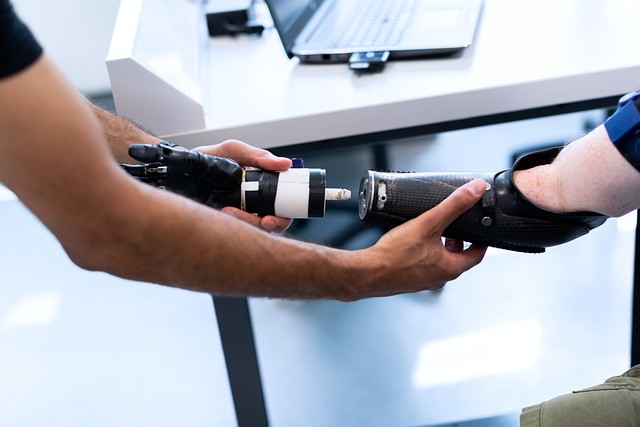
Myoelectric prosthetics offer exciting possibilities. They give children with congenital limb differences a way to do more with less effort. But like any solution, they come with trade-offs. Understanding both the advantages and the challenges can help parents and children make a decision that feels right—one that supports not just what the child can do, but who they are becoming.
Advantages That Support Daily Life and Confidence
One of the biggest strengths of myoelectric arms is that they allow for more natural movement. The hand can open and close with just a muscle signal, which means no straps or cables are needed. This makes the prosthetic easier to wear and more comfortable over time. It also looks more like a real arm, which can help boost a child’s confidence, especially in public or at school.
Myoelectric devices also allow for more precision in movement. Children can grip a pencil, hold a cup, or pick up small toys with better control. Over time, this can help with balance, posture, and full-body coordination. The more a child can do on their own, the more confident and independent they feel.
At Robobionics, we focus on real-world results. Our myoelectric arms are built for everyday tasks—writing, eating, learning, and playing. We don’t just design for looks—we design for life.
Challenges That Need Thoughtful Planning
Despite their benefits, myoelectric prosthetics come with challenges. These devices require daily charging, careful handling, and regular maintenance. If dropped or exposed to water, the electronics can be damaged. For younger children or those very active outdoors, this can be a concern.
Another challenge is the learning curve. Using a myoelectric arm requires training. The child must learn to control specific muscles they may not have used before. While this becomes easier with time, it can be frustrating at first. Without support, some children stop using the prosthetic, even if it could help.
At Robobionics, we guide families through these challenges from day one. We offer training at home, ongoing check-ins, and child-friendly tools that make learning fun and stress-free.
The Cost and Long-Term Commitment
Myoelectric arms are typically more expensive than passive or body-powered options. The technology, batteries, motors, and sensors all add to the cost. That’s why it’s important to see this device as a long-term investment—not something to rush into too early.
Families should consider whether their child is ready—not just physically, but emotionally and socially. A child who is eager to learn and motivated to use both limbs is more likely to succeed with a myoelectric arm. Age matters, but readiness matters more.
Robobionics offers payment plans, maintenance packages, and upgrade options that help families manage costs over time. We want every child to have access to smart solutions without financial pressure.
Assessing Readiness for a Myoelectric Arm

Introducing a myoelectric prosthetic isn’t about age alone—it’s about timing, willingness, and readiness. Some children are excited to try new things and have the focus to learn. Others may need more time to feel comfortable. Understanding when a child is truly ready for a myoelectric arm is key to long-term success and daily use.
Observing Interest and Motivation
One of the first signs of readiness is curiosity. If a child asks about prosthetics, shows interest in using both hands, or wants to do more things independently, these are strong indicators. They might express a desire to hold a toy with both hands, carry school supplies on their own, or participate in an activity that would be easier with two limbs.
This natural motivation is more powerful than any external pressure. When the child wants to use the prosthetic, they are more likely to put in the effort to learn. This internal drive helps them stick with training, even if it feels hard in the beginning.
At Robobionics, we look for this motivation during our first assessments. We talk to the child, not just the parents. When children feel included in the process, they take ownership of their progress.
Physical and Emotional Readiness
Even if a child is curious, they also need to be physically and emotionally ready. This includes having enough muscle strength in the residual limb to control the sensors. It also includes being comfortable with wearing the prosthetic for longer periods of time.
Some children may feel frustrated at first if they don’t get it right away. Emotional readiness means being able to keep trying, with gentle encouragement from family and therapists. If a child gives up quickly or doesn’t enjoy the process, it may be better to wait a bit longer before introducing a myoelectric device.
At Robobionics, we do a detailed readiness check. We assess the muscle signals, measure the fit, and make sure the child is emotionally in a good place to begin. If not, we work with families to build up to that moment gradually, using games, therapy, and encouragement.
Creating the Right Environment for Success

Even if a child is ready, the environment around them needs to support the journey. This means giving them time to practice without pressure, having access to proper training, and ensuring they feel encouraged—not judged. Support from parents, teachers, and friends can make a big difference in how a child uses their prosthetic.
Children need to feel that their prosthetic is a tool, not a burden. If they are constantly being reminded to wear it or scolded when they forget, they may begin to resist using it. On the other hand, if they are celebrated for every small win, they begin to see it as a part of themselves.
Robobionics offers family coaching, teacher training, and follow-up care to create a strong support system. We don’t just hand over a prosthetic—we walk with families every step of the way.
Supporting Long-Term Success With Myoelectric Arms
Once a child starts using a myoelectric arm, the journey doesn’t stop there. Continued support, guidance, and encouragement are what help the prosthetic become a true extension of the body. Myoelectric arms are powerful tools, but to reach their full potential, they must be part of a long-term care plan that grows with the child.
Ongoing Training and Adaptation
Learning how to use a myoelectric arm takes time. The first few weeks are all about exploration—figuring out which muscles to activate and how to control the device. But even after the basics are learned, children need regular practice to improve speed, accuracy, and comfort.
As the child grows and their daily tasks change, the prosthetic must also adapt. What worked for holding blocks at age six may need upgrading for writing, cooking, or sports at age ten. Continuous training helps the child adjust as their needs evolve.
At Robobionics, we offer gamified therapy programs, home-based exercises, and clinic follow-ups to make learning fun and consistent. We believe that a prosthetic should grow with the child, and our team is always ready to help make those transitions smooth.
Building Confidence Through Use
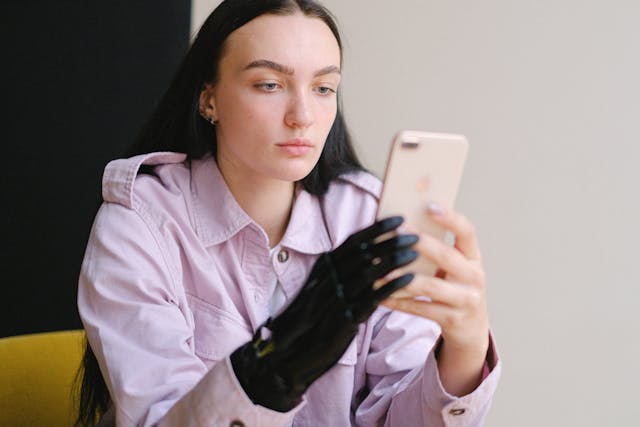
Using a myoelectric prosthetic is more than learning movements—it’s about building confidence. When a child can do something new, like grip a spoon or shake hands with someone, it sends a powerful message: “I can do this.” These moments help children see their limb difference not as a limitation but as part of who they are.
Encouraging the child to use their arm in public, share their story, or take part in new activities builds both skill and pride. Over time, they stop seeing the device as separate and start seeing it as part of themselves.
Robobionics celebrates these wins with our users—whether it’s the first successful button-up shirt or carrying a schoolbag with both hands. Every milestone matters, and every story is worth sharing.
Preparing for the Future
As the child grows into adolescence, they’ll have more say in their care. Teens may want to upgrade to a more advanced hand or explore a different grip style. Some may be interested in joining vocational training, sports programs, or even competitive activities that need a higher-functioning limb.
It’s important that the prosthetic care team stays involved during these transitions. This ensures that the device always matches the user’s body, goals, and personality. It also gives the young person a sense of control over their own journey.
At Robobionics, we stay with our users for the long haul. From early childhood to adulthood, we’re here to ensure every user gets not just the right fit—but the right future.
Conclusion
Myoelectric arms are one of the most exciting developments in prosthetic care, especially for children with congenital limb deficiencies. They offer movement, independence, and confidence—but they also require patience, practice, and the right timing. These devices are not a one-size-fits-all solution. They’re most successful when they match a child’s readiness, motivation, and lifestyle.
Choosing a myoelectric prosthetic is not about pushing technology for its own sake. It’s about asking the right questions: Is my child ready? Will this help them do more? Do they want this as part of their life?
At Robobionics, we walk families through those questions every day. We combine cutting-edge design with child-friendly care and practical support. Because we know that the best prosthetic is not just the most advanced—it’s the one that helps your child move forward with confidence.
Thinking about a myoelectric arm for your child? Let’s talk. Book a free consultation with Robobionics today and take the next step toward a stronger, smarter future.



